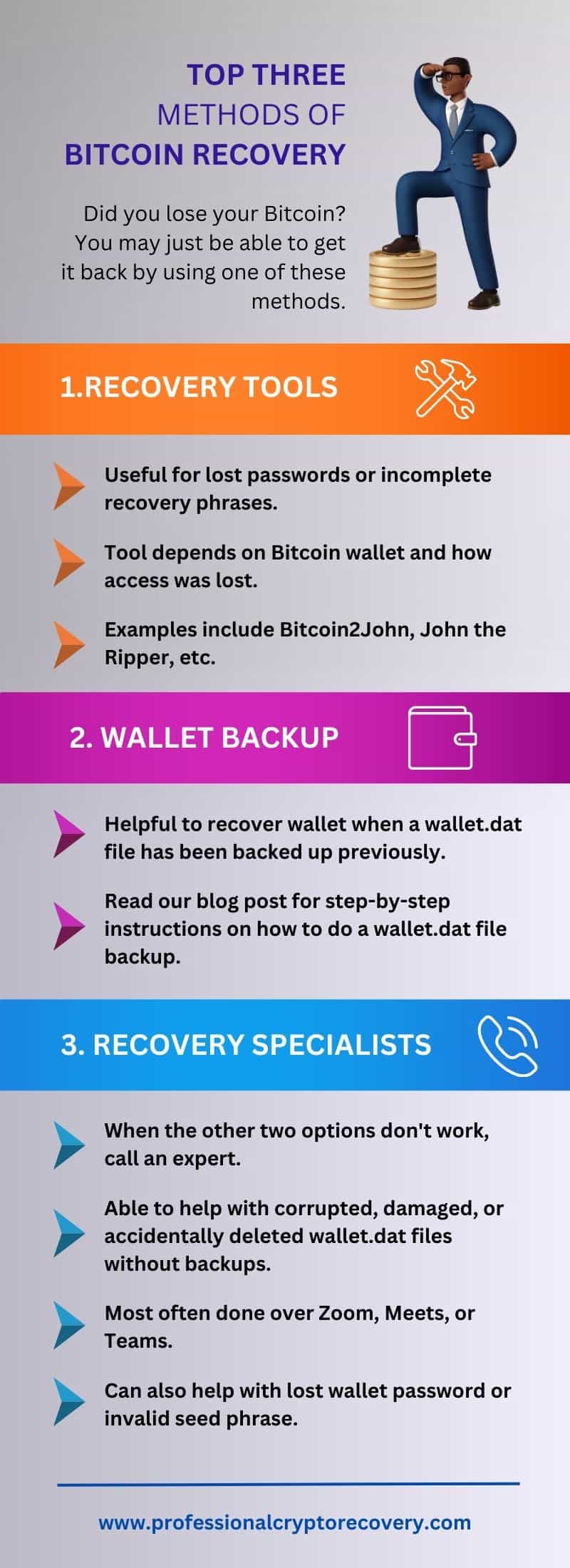Losing Bitcoin (BTC) is an unfortunate but not-so-uncommon occurrence. In some cases, like a hacked wallet or phishing attack, nothing can be done to remedy the situation. But in others, it is still possible to recover your valuable crypto. These include a forgotten wallet password, an incomplete seed phrase, or a damaged/corrupted file. If you find yourself in this category, what options do you have?
Here are the top 3 methods of bitcoin recovery that you can use to recover your lost or inaccessible Bitcoin (BTC). The usefulness of each depends on your specific situation.

1. Using recovery tools
The internet is full of specialized tools people can use to recover a Bitcoin wallet if they lose their password or have an incomplete recovery phrase. Some of the tools are open source, meaning they are free for anyone to download and use, and/or check the source code. Others require you to purchase a license.
Some good options include Bitcoin2john, John the Ripper, Hashcat, BTC Recover, and Ian Coleman’s BIP39 Mnemonic Code Converter. The specific tool you use will depend on your Bitcoin wallet and how you lost access to it. Did you forget the password, lose part of the seed phrase, or is the seed phrase in the wrong order?
For example, Bitcoin2john is a Python script used when recovering the password of a Bitcoin Core wallet. It works by extracting hashes from the wallet.dat file. These hashes can then be brute-forced for passwords by another tool, like John the Ripper or Hashcat.
They’re not Bitcoin-specific, but support various hash algorithms, including those used by Bitcoin wallets. They also feature various attack modes for cracking passwords, including brute force, dictionary, hybrid, and masked attacks.
BTC Recover and Ian Coleman’s BIP39 Mnemonic Code Converter are two more tools that can be used to help with Bitcoin recovery. The former requires quite a bit of technical knowledge since it is a command-line tool. As for the latter, it is used to convert BIP39 mnemonic phrases into the corresponding keys and vice versa.
Overall, you need to be careful when using these tools to recover your wallet’s keys. One way to ensure absolute security is to attempt your recovery on an air-gapped computer. This is a device that is completely isolated from the internet or local area networks (LANs). It stops potential external threats from stealing your wallet’s crucial information.
2. Restoring your wallet.dat file
The wallet.dat file is a database file used by core wallets, like Bitcoin Core. It contains some crucial data about the wallet, including the public and private keys. This is what makes it possible to use the file to recover a wallet and the Bitcoin it holds. So, in which situation is restoring wallet.dat useful?
Well, the file is crucial to the working of a wallet. If it goes missing due to accidental deletion or a virus, the wallet will stop working properly. The same applies if it is damaged or corrupted by a virus or as a result of physical damage to the storage device.
Fortunately, you can prepare yourself for these scenarios by backing up your wallet.dat file. This involves finding the specific location where the file is stored on your device (which varies depending on the operating system) and copying it to a secure drive. This ensures you’ll have it at hand if the situation ever requires it.
When that happens, you’ll find that restoring wallet.dat is quite easy. All you have to do is copy the backup and paste it to its appropriate folder.
The wallet application will recognize the new wallet.dat file, with its private and public keys, and use them to restore your bitcoins. However, make sure that you close the wallet before pasting the file to avoid any potential conflicts.
3. Bitcoin recovery specialists
The previous two options in this list are DIY. But what happens when they fail? Well, it becomes time to call in experts, like Professional Crypto Recovery (PRC).
Recovery specialists are professionals who specialize in helping people recover lost cryptocurrencies. They are the best option when there is nothing you can do yourself to recover your cryptocurrencies.
For example, if your wallet.dat is corrupted, damaged, or accidentally deleted and you have no backup, you can only get it back with the help of an expert. This may involve sending the storage device over to the professional, especially if it’s physically damaged, so they can use their data recovery skills to restore it.
If your device is still intact, it is possible for the process to be done remotely. The recovery expert will guide you through the process of getting the file over a Zoom, Meets, or Teams call.
A more common scenario that requires an expert is a lost wallet password or an invalid seed phrase. This is because most people aren’t familiar with Bitcoin recovery tools as the software tends to be quite complex. Thus, a significant number of attempts by regular people to use these tools will probably bear no fruit.
Fortunately, Bitcoin recovery specialists are masters at using these tools. Combine that with skills in cryptography and data recovery and you have someone who is better placed to help you recover your lost password/seed phrase and thus, regain access to your crypto assets.
Think you might need professional help? Professional Crypto Recovery is ready to help! Give us a call today.